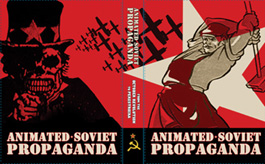home | metro silicon valley index | movies | current reviews | DVD review

Eastern Block waters: Jove Films surveys the anti-U.S. cartoons of the Soviet Union.
Seeing Red
A new collection of Soviet-era propaganda shows how cartoons fought the Cold War
By Richard von Busack
KRUSTY THE KLOWN from The Simpsons once had to fill up a dead spot on his program with a little Eastern Block animation. Die-hard cartoon fans at once recognized the squiggly, stop-motion style of the "Worker and Parasite" cartoon as a parody of Yugoslavia's Zagreb Films. For genuine Communist animation, the state of the art collection is—such as it is—Animated Soviet Propaganda, from Jove Films. The collection claims that the series includes work "from the October Revolution to Perestroika." Actually, most of the work here is from Soyuzmultfilm, Russia's premier animation studio, which created some 1,500 cartoons before it was gutted during privatization.
Sadly, the graphic thrust of 1920s Soviet art was long gone by the time Soyuzmultfilm started. And Stalin killed off or scared off many artists. Even the corpse-faced Uncle Sam on the cover of this set isn't scary Russian propaganda but rather an image from a Westerner's protest sign in an anti-Vietnam war march. The marchers bearing this Uncle Corpse come at the end of a historically interesting antiwar cartoon called Ave Maria. This cartoon is only propaganda by name, since the Russian animator has all due sympathy for the parents of the U.S. soldiers killed in Vietnam.
San Francisco.com Real Estate
Moving to the Bay Area just became easy. Let San Francisco.com show you all the homes currently for sale.
San Jose.com Real Estate
Relocating to San Jose or Silicon Valley? Let San Jose.com introduce you to some expert area real estate agents.
As close to a genuinely foreign style as we see here is the earliest piece in the set, the extraordinarily cryptic 1933 Black and White about racial atrocities, with Paul Robeson moaning "Motherless Child" on the soundtrack. Someone Else's Voice (1949) has a stodgy moral—don't listen to decadent Western jazz!—but its visuals are a Russian answer to Bambi, complete with multiplane animation of the forest full of Disney birds. Lacking a punch line as it does, The Millionaire (1968), easily the best short here, may have been influenced by Tex Avery's flat color fields and animated bulldogs. As in Avery's works, swing music (permitted at last in the USSR) fills the soundtrack. It is a comedy about a pooch who inherits a fortune and becomes a U.S. senator. Both sides of the Cold War could enjoy this one; the gag of an undeserving pet inheriting a fortune turned up in a few Warner Bros. cartoons, too.
V. Tarasov's 1979 Shooting Range owes a graphic debt to Peter Max and Marvel cartoonist Jim Steranko. A desperate youth gets a gig as a human target in a shooting gallery. The film evinces drug-era nostalgia, with wide-eyed, bell-bottomed characters who look like they have just disembarked from a yellow submarine. And Tarasov's grinning capitalist, who looks oddly like Batman's foe the Joker, makes an effectively loathsome rich villain.
The set lacks adequate documentation. The cartoon subtitles are misspelled and given odd, rhyming translations. In the not-very-useful documentary included with the set, narrators denounce the cartoons for portraying Americans as "evil racists, unemployed exploited workers and warmongers." That would be more hurtful if the population of America did not in fact include evil racists, unemployed, exploited workers and warmongers. Rather than whipping the cadaver of the USSR, it would have been more useful to trace the evolution of animated styles on the other side of the world.
![]() Animated Soviet Propaganda, a DVD set, retails for $100.
See www.jovefilm.com for details.
Animated Soviet Propaganda, a DVD set, retails for $100.
See www.jovefilm.com for details.
Send a letter to the editor about this story.
|
|
|
|
|
|
